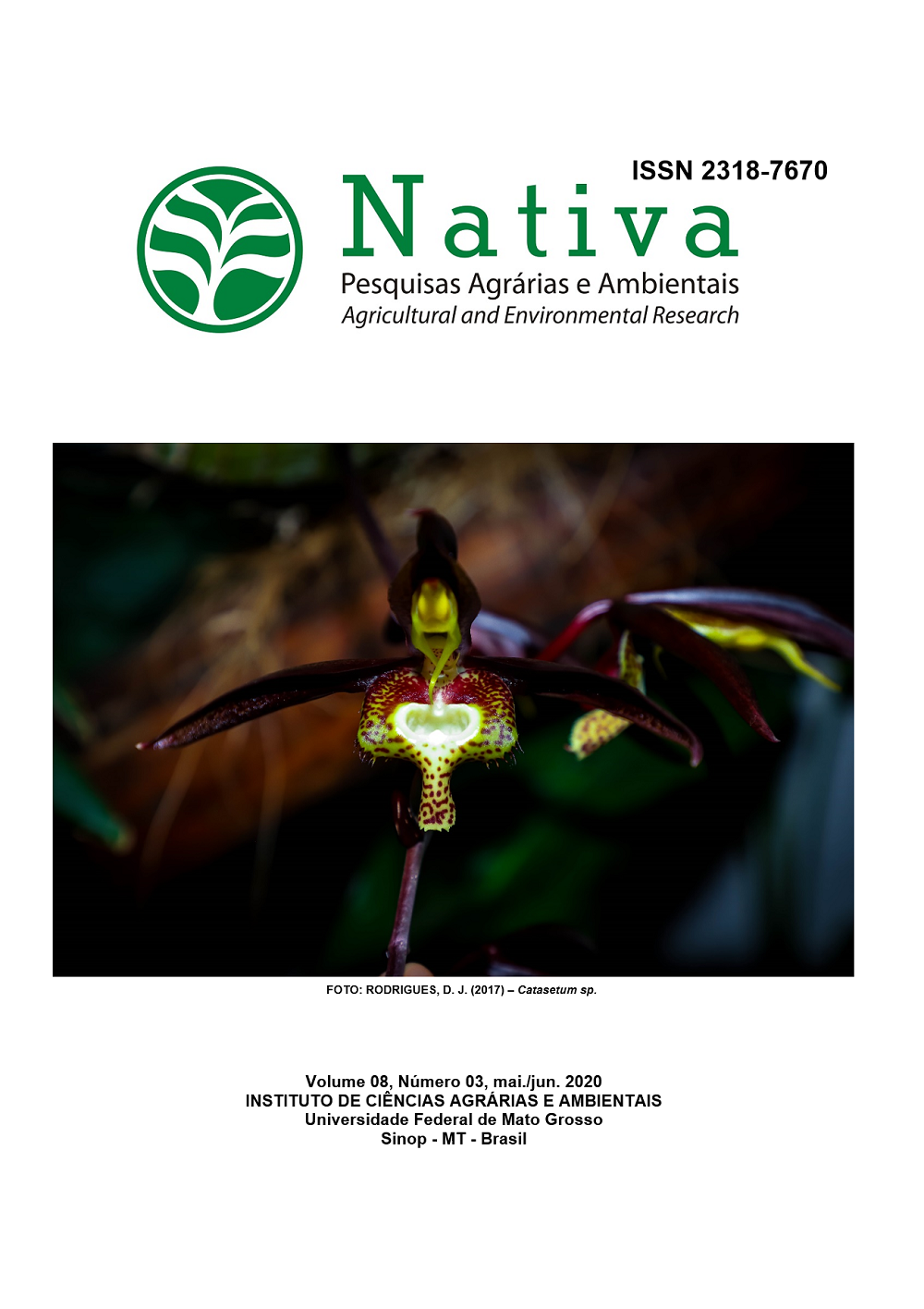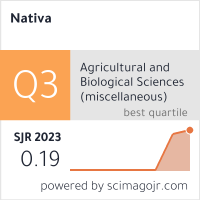MODELAGEM DO CRESCIMENTO E PRODUTIVIDADE DO ALGODÃO EM CULTIVO COMERCIAL NO CERRADO BAIANO
DOI:
https://doi.org/10.31413/nativa.v8i3.10029Resumo
A análise de crescimento e produção dos cultivos é fundamental para avaliar a interação das culturas com o ambiente e práticas agrícolas. Neste estudo, avaliações sobre o crescimento e produtividade do algodoeiro foram conduzidas em um sistema comercial de produção sob regime de sequeiro, submetido a duas diferentes fontes de nitrogênio no município de Luís Eduardo Magalhães, Bahia. O objetivo foi avaliar o ajuste dos modelos logístico e exponencial, respectivamente, às variáveis de crescimento do algodão e o índice de área foliar (IAF), em função dos graus-dia acumulado (GDA). Para isso, foram realizadas observações na safra 2014/15 dos seguintes parâmetros biométricos: altura da planta, biomassa total, biomassa de caule, folhas e estruturas reprodutivas. Os modelos logísticos e exponenciais ajustados em função dos GDA mostraram-se capazes de representar satisfatoriamente a variação dos parâmetros biométricos avaliados, com coeficiente de regressão ajustado (R2ajs) entre 0,88 e 0,99. A produtividade média de algodão em caroço oscilou entre 5263,4 e 3891,5 kg ha-1 e o rendimento de pluma entre 2300,1 e 1688,9 kg ha-1. Conclui-se que os modelos ajustados podem ser utilizados para auxiliar na análise de crescimento vegetal, quando relacionados aos GDA, além de permitirem obter coeficientes biométricos utilizados em modelos dinâmicos.
Palavras-chave: solos tropicais; partição de biomassa; modelos de crescimento.
MODELING OF COTTON GROWTH AND YIELD IN COMMERCIAL AREA IN BAHIA CERRADO
ABSTRACT:
Growth analysis and yield of crops are key to evaluate the interaction of crops with the environment and agricultural practices. In this study, assessments of cotton growth and yield were carried out in a commercial production system in rainfed regime, submitted to two different sources of nitrogen in in the municipality of Luís Eduardo Magalhães, State of Bahia, Brazil. The aim was to assess the fit of logistic and exponential models, the growth variables cotton and the leaf area index, due to cumulative degree-days (CDD). During the period from 11/2014 to 07/2015 of the following biometric parameters observations were made: plant height, total biomass, biomass of stems, leaves and reproductive structures. The logistic and exponential models, fitted according to the CDD, were able to satisfactorily represent the variation of the evaluated biometric parameters, with a fitted regression coefficient (R2ajs) between 0.88 and 0.99. The average yield of cotton ranged between 5263.4 and 3891.5 kg ha-1 and the plume yield between 2300.1 and 1688.9 kg ha-1. It is concluded that the fitted model may be used to aid in the plant growth analysis when related to the CDD, besides enabling to obtain biometric coefficients in dynamic models.
Keywords: tropical soils; biomass partitioning; growth models.
Referências
ANDRADE NETO, R. C.; MIRANDA, N. O.; DUDA, G. P.; GÓES, G. B.; LIMA, A. S. Crescimento e produtividade do sorgo forrageiro BR 601 sob adubação verde. Revista Brasileira de Engenharia Agrícola e Ambiental, Campina Grande, v. 14, n. 2, p. 124-130, 2010. DOI: https://dx.doi.org/10.1590/S1415-43662010000200002
BANGE, M. P.; MILROY, P. S. Timing of crop maturity in cotton impact of dry matter production and partitioning. Ed. Elsevier. Field Crops Research, Amsterdam, v. 68, n. 2, p. 143-155, 2000. DOI: https://dx.doi.org/10.1016/S0378-4290(00)00116-7
BANGE, M. P.; MILROY, P. S. Growth and dry matter of diverse cotton genotypes. Ed. Elsevier. Field Crops Research, Amsterdam, v. 87, n. 1, p. 73–87, 2004. DOI: https://dx.doi.org/10.1016/j.fcr.2003.09.007
BANGE, M. P.; MILROY, P. S.; THONGBAI, P. Growth and yield of cotton in response to waterlogging. Ed. Elsevier. Field Crops Research, Amsterdam, v. 88, n. 2-3, p. 129-142, 2004. DOI: https://dx.doi.org/10.1016/j.fcr.2003.12.002
BELTRÃO, N. E. M. et al. Fitologia do algodoeiro herbáceo: sistemática, organografia e anatomia. In: BELTRÃO, N. E. M; AZEVEDO, D. M. P. (Ed.). O Agronegócio do algodão no Brasil. 2. Ed. Brasília: Embrapa Informação Tecnológica, 2008. 1 v. cap. 6. p. 181-217.
CONAB_COMPANHIA NACIONAL DE ABASTECIMENTO. Acompanhamento de safra brasileira de grãos, v. 7 - Safra 2019/20 - Sétimo levantamento, Brasília, 2020. p. 1-25. Disponível em: <https://www.conab.gov.br/info-agro/safras/graos/boletim-da-safra-de-graos>. Acesso em: 17 abr. 2020.
DAI, J.; WEIJIANG, L.; TANG, W.; ZHANG, D.; LI, Z.; LU, H.; ENEJI, E. A.; DONG, H. Manipulation of dry matter accumulation and partitioning with plant density in relation to yield stability of cotton under intensive management. Field Crops Research, Amsterdam, v.180, p.207-215, 2015. DOI: https://dx.doi.org/10.1016/j.fcr.2015.06.008
DU, X.; CHEN, B.; MENG, Y.; ZHAO, W.; ZHANG, Y.; SHEN, T.; WANG, Y.; ZHOU, Z. Effect of cropping system on cotton biomass accumulation and yield formation in double-cropped wheat-cotton. International Journal of Plant Production, v. 10, n. 1, p. 29-44, 2016. DOI: http://dx.doi.org/10.22069/ijpp.2016.2551
FERREIRA, B. C. A.; LAMAS, M, F.; CARVALHO, S. da C. M.; SALTON, C. J.; SUASSUNA, D. N. Produção de biomassa por cultivos de cobertura do solo e produtividade do algodoeiro em plantio direto. Pesquisa Agropecuária Brasileira, Brasília, v. 45, n. 6, p. 546-553, 2010. DOI: http://dx.doi.org/10.1590/S0100-204X2010000600003
LYRA, G. B.; SOUZA, L. J. de; Lyra, G. B.; TEODORO, I.; MOURA FILHO, G. Modelo de crescimento logístico e exponencial para o milho br 106, em três épocas de plantio. Revista Brasileira de Milho e Sorgo, Sete Lagoas, v. 7, n. 3, p. 211-230, 2008.
LUO, Q.; BANGE, M.; CLANCY, L. Cotton crop phenology in a new temperature regime. Ecological Modelling, v. 285, p. 22-29, 2014. DOI: https://doi.org/10.1016/j.ecolmodel.2014.04.018
MAO, L.; ZHANG, L.; ZHAO, X.; LIU, S.; WERF, Wopke van der; ZHANG, S.; SPIERTZ, H.; LI, Z. Crop growth, light utilization and yield of relay intercropped cotton as affected by plant density and plant growth regulator. Field Crops Research, Amsterdam, v. 155, p. 67-76, 2014. DOI: https://dx.doi.org/10.1016/j.fcr.2013.09.021
MONTEIRO, J. E. SENTELHAS, C. P.; CHIAVEGATO, J. E.; GUISELINI, C.; SANTIAGO, V. A.; PRELA, A. Estimação da área foliar do algodoeiro por meio de dimensões e massa das folhas. Revista Bragantia, Campinas, v. 64, n. 1, p. 15-24, 2005. DOI: http://dx.doi.org/10.1590/S0006-87052005000100002
MOREIRA, M. C.; SILVA, D. D. da. Atlas hidrológico da bacia hidrográfica do Rio Grande, Barreiras, BA. Barreiras: Editora Gazeta Santa Cruz, 2010. 80 p. Disponível em: <http://www.terrabrasilis.org.br/ecotecadigital/images/abook/pdf/Atlas%20hidrolgico%20da%20bacia%20hidrogrfica%20do%20Rio%20Grande.pdf>. Acesso em: 28 dez 2016.
PEDROSA, B. M.; MORELLO, L. C.; SILVA FILHO, L. J.; FREIRE, C. E.; SUASSUNA, D. N.; OLIVEIRA, P. W.; ALENCAR, R. A. de; TAVARES, A. J.; OLIVEIRA, R. E. de. Estimativa de produtividade e perda por apodrecimento em cultivares de algodoeiro no cerrado da Bahia, safra 2014/15. In: Boletim técnico, Divulgação dos resultados de pesquisas safra 2014-15. Fundação Bahia: Pesquisa aplicada ao campo e transferência de tecnologia. N.2, 2015. Disponível em: <http://www.congressodoalgodao.com.br/anais/resumos/R0206-9.html>. Acesso em: 12 abr 2020.
REDDY, V. R.; REDDY, K. R.; BAKER, D. N. Temperature effect on growth and development of cotton during the fruiting period. Agronomy Journal, Madison, v. 83, p. 211-217, 1991. DOI: http://dx.doi.org/10.2134/agronj1991.00021962008300010050x
SANTOS, D. C. F. et al. Adubação de manutenção com nitrogênio e enxofre para o algodoeiro cultivado em solo arenoso do cerrado baiano. In: Simpósio Nacional do Cerrado; Simpósio Internacional de Savanas Tropicais, 9., 2., 2008. Anais... Brasília: Ed. Parlamundi, 2008. Não paginado.
SEVERINO, S. L.; RODRIGUES, M. M. S.; CHITARRA, G. L.; LIMA FILHO, J.; CONTINI, E.; MOTA, M.; MARRA, R.; ARAÚJO, A. Produto: ALGODÃO - Parte 01: Caracterização e Desafios Tecnológicos. Série desafios do agronegócio brasileiro (NT3). 2019. Disponível em: <https://ainfo.cnptia.embrapa.br/digital/bitstream/item/198192/1/SerieDesafiosAgronegocioBrasileiroNT3Algodao.pdf>. Acesso em: 12 mar 2020.
SOUZA, R. J.; CASTRO, A. S. G.; RIBEIRO, N. B.; ROLIM, V. M.; KANEKO, H. F. Manejo de nitrogênio revestido com polímeros na cultura do algodão. Acta Iguazu, Cascavel, v. 2, n. 1, p. 43-49, 2013.
TEIXEIRA, R. I.; KIKUTI, H.; BORÉM, A. Crescimento e produtividade de algodoeiro submetido a cloreto de mepiquat e doses de nitrogênio. Revista Bragantia, Campinas, v. 67, n.4, p.891-897, 2008. DOI: http://dx.doi.org/10.1590/S0006-87052008000400011
United States Department of Agriculture. USDA Agricultural Projections to 2027. 2018. Disponível em:<https://www.ers.usda.gov/webdocs/publications/87459/oce-2018-1.pdf?>. Acesso em: 15 mar 2020.
UNRUH, B. L.; SILVERTOOTH, J. C. Comparison between upland and a Pima cotton cultivars I. Growthandyield. Agronomy Journal, Madison, v. 88, n. 4, p. 583-589, 1996. DOI: http://dx.doi.org/10.2134/agronj1996.00021962008800040015x
YANG, G.; TANG, H.; TONG, J.; NIE, Y.; ZHAG, X. Effect of fertilization frequency on cotton yield and biomass accumulation. Ed. Elsevier. Field Crops Research, Amsterdam, v. 125, p. 161-166, 2012. DOI: https://dx.doi.org/10.1016/j.fcr.2011.08.008
WENDEL, J. F.; BRUBAKER, C. L.; SEELANAN, T. The Origin and Evolution of Gossypium. In: STEWART, J. M.; OOSTERHUIS, D. M.; HEITHOLT, J. J.; MAUNEY, J. R. (Ed.) Physiology of Cotton. Springer, Dordrecht, 2010. p. 1-18. DOI: https://dx.doi.org/10.1007/978-90-481-3195-2_1
WILMOTT, C. J. Some comments on the evaluation of model performance. Bulletin American Meteorology Society, v. 64, p. 1309-1313, 1982. DOI: https://dx.doi.org/10.1175/1520-0477(1982)063%3C1309:SCOTEO%3E2.0.CO;2
Downloads
Publicado
Edição
Seção
Como Citar
Licença
Direitos Autorais para artigos publicados nesta revista são do autor, com direitos de primeira publicação para a revista. Em virtude de a aparecerem nesta revista de acesso público, os artigos são de uso gratuito, com atribuições próprias, em aplicações educacionais e não-comerciais.
A artigos publicados nessa revista, podem ser reproduzidos parcialmente ou utilizados como referência por outros autores, desde que seja cita a fonte, ou seja, a Revista Nativa.
Copyright for articles published in this journal are the authors, with first publication rights granted to the journal. The journal shows open access, and articles are free to use, with proper attribution, in educational and non-commercial.
The articles published in this journal may be reproduced in part or used as a reference by other authors, provided that the source is quoted.






